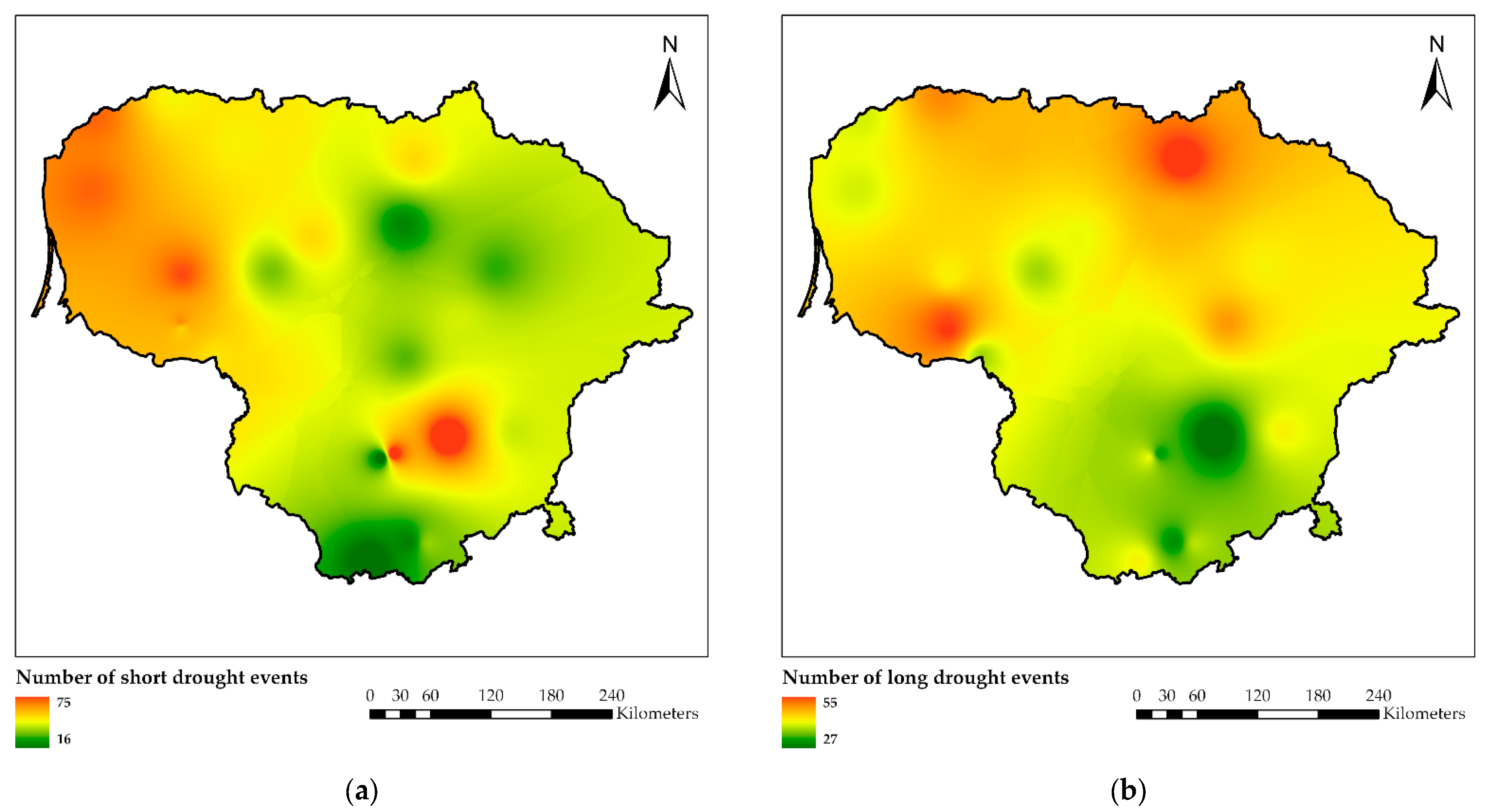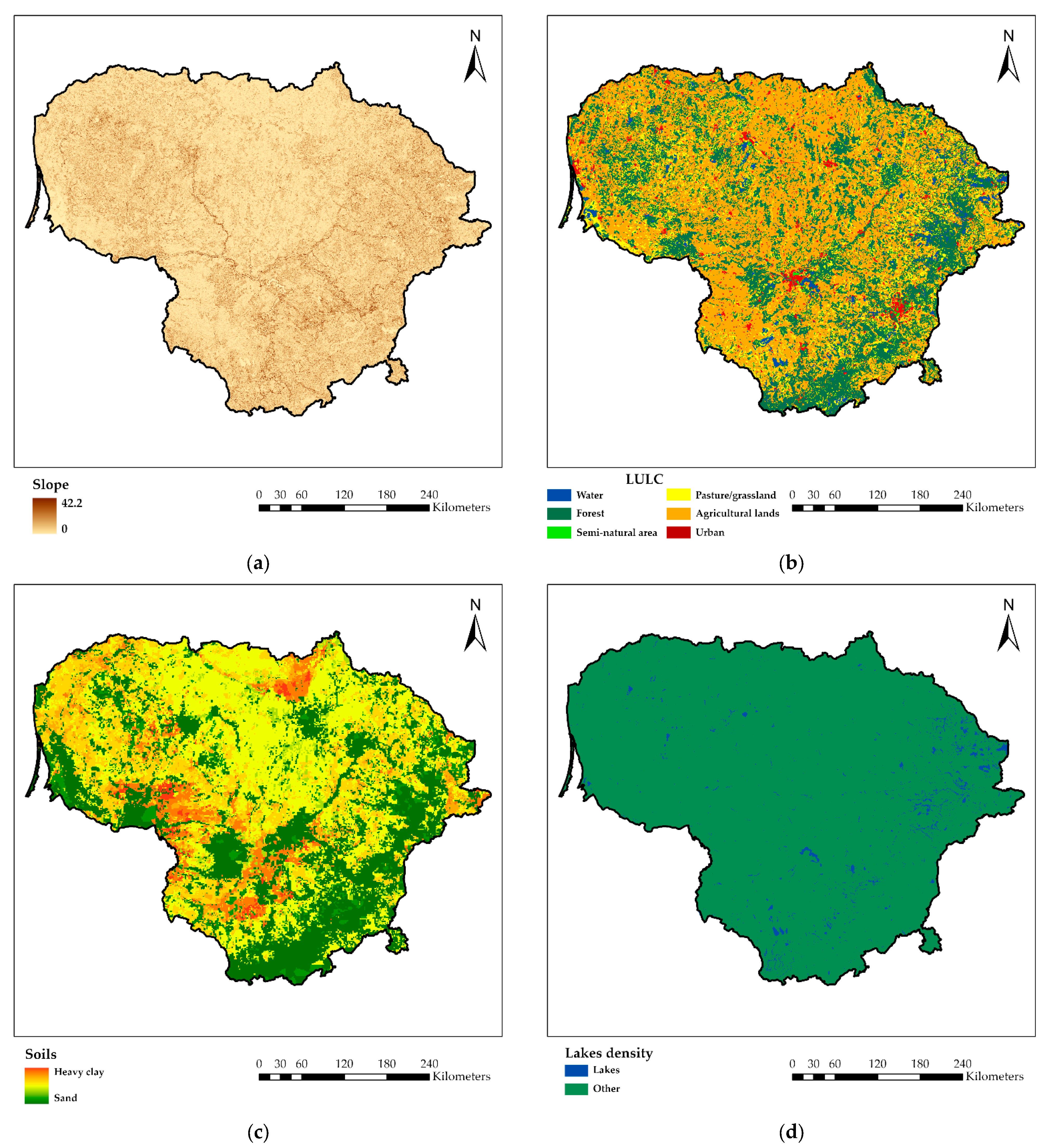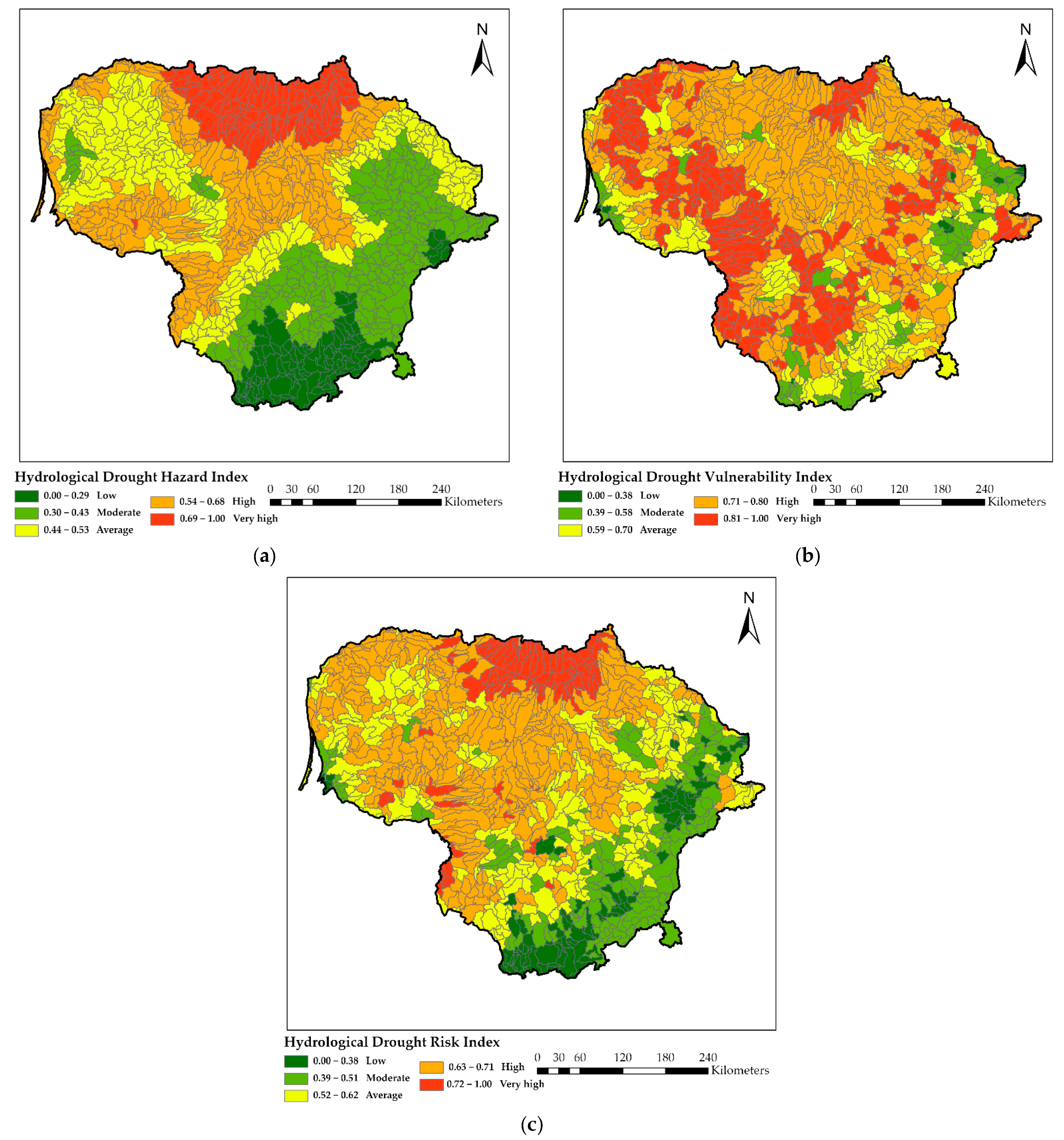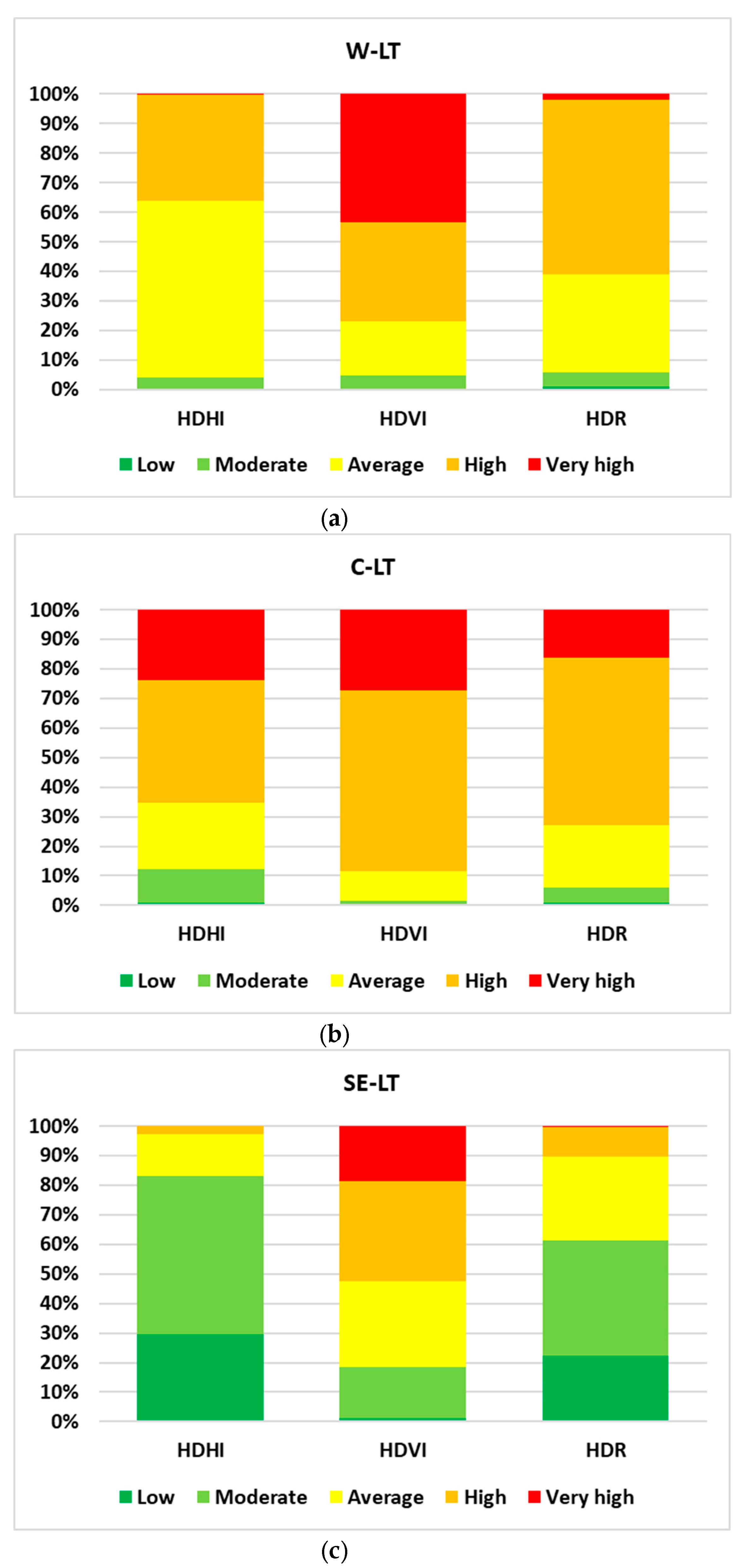Evaluating Hydrological Drought Risk in Lithuania
Abstract
:1. Introduction
2. Materials and Methods
2.1. Study Area and Data
2.2. Methods
2.2.1. Data Preparation
2.2.2. Drought Risk Calculation
- Number of hydrological droughts lasting 5–16 days—WSD;
- Number of hydrological droughts lasting more than 16 days—WLD;
- Average precipitation—R;
- Dependence of river runoff on rainfall—RD.
- Slope—S;
- Land use/land cover type—LULC;
- Morphological composition of soils—SL;
- Lake density—L.
2.2.3. Spatial Analysis
2.2.4. Index Calculation Method
Hydrological Drought Hazard Component Indices
- The number of droughts lasting 5–16 days and more than 16 days.
- Average precipitation.
- The impact of rainfall regime.
Hydrological Drought Vulnerability Component Indices
2.2.5. Rescaling Sets of Variables
3. Results
3.1. Hydrological Drought Hazard, Vulnerability and Risk at the Lithuanian Scale
3.2. Hydrological Drought Hazard, Vulnerability and Risk at the Hydrological Regions Scale
3.3. Hydrological Drought Hazard, Vulnerability and Risk at the Basins Scale
4. Discussion
5. Conclusions
Author Contributions
Funding
Data Availability Statement
Acknowledgments
Conflicts of Interest
References
- Wilhite, D.A. Moving toward Drought Risk Management: The Need for a Global Strategy; National Drought Mitigation Center: Lincoln, NE, USA, 1992. [Google Scholar]
- Hayes, M.J.; Svoboda, M.; Wall, N.A.; Widhalm, M. The Lincoln Declaration on Drought Indices: Universal Meteorological Drought Index Recommended. Bull. Am. Meteorol. Soc. 2011, 92, 485–488. [Google Scholar] [CrossRef] [Green Version]
- Hasan, H.H.; Mohd Razali, S.F.; Muhammad, N.S.; Ahmad, A. Research Trends of Hydrological Drought: A Systematic Review. Water 2019, 11, 2252. [Google Scholar] [CrossRef] [Green Version]
- Intergovernmental Panel on Climate Change (IPCC). Summary for Policymakers. In Climate Change 2021: The Physical Science Basis; Contribution of Working Group I to the Sixth Assessment Report of the Intergovernmental Panel on Climate Change; Masson-Delmotte, V., Zhai, P., Pirani, A., Connors, S.L., Péan, C., Berger, S., Caud, N., Chen, Y., Goldfarb, L.M.I., Huang, M., et al., Eds.; Cambridge University Press: Cambridge, UK, 2021. [Google Scholar] [CrossRef]
- Mishra, A.K.; Singh, V.P. A review of drought concept. J. Hydrol. 2010, 391, 202–216. [Google Scholar] [CrossRef]
- Asadieh, B.; Krakauer, N.Y. Global change in streamflow extremes under climate change over the 21st century. Hydrol. Earth Syst. Sci. 2017, 21, 5863–5874. [Google Scholar] [CrossRef] [Green Version]
- United Nations Office for Disaster Risk Reduction (UNDRR). GAR Special Report on Drought 2021; United Nations Office for Disaster Risk Reduction (UNDRR): Geneva, Switzerland, 2021; Available online: https://www.undrr.org/quick/13641 (accessed on 19 June 2023).
- Boretti, A.; Rosa, L. Reassessing the projections of the World Water Development Report. npj Clean Water 2019, 2, 15. [Google Scholar] [CrossRef] [Green Version]
- Engström, J.; Jafarzadegan, K.; Moradkhani, H. Drought Vulnerability in the United States: An Integrated Assessment. Water 2020, 12, 2033. [Google Scholar] [CrossRef]
- Narasimhan, B.; Srinivasan, R. Development and evaluation of Soil Moisture Deficit Index (SMDI) and Evapotranspiration Deficit Index (ETDI) for agricultural drought monitoring. Agric. For. Meteorol. 2005, 133, 69–88. [Google Scholar] [CrossRef]
- Modarres, R. Streamflow drought time series forecasting. Stoch. Environ. Res. Risk Assess. 2007, 21, 223–233. [Google Scholar] [CrossRef]
- McKee, T.B.; Doesken, N.J.; Kleist, J. The Relationship of Drought Frequency and Duration to Time Scales. In Proceedings of the 8th Conference on Applied Climatology, Anaheim, CA, USA, 17–22 January 1993; pp. 179–184. [Google Scholar]
- Palmer, W.C. Meteorologic Drought; Research Paper No. 45; US Department of Commerce: Washington, WA, USA, 1965; pp. 1–58. [Google Scholar]
- European Commission; Joint Research Centre; Cammalleri, C.; Pischke, F.; Masante, D.; Barbosa, P.; Naumann, G.; Spinoni, J.; Erian, W.; Vogt, J.V.; et al. Drought Risk Assessment and Management—A Conceptual Framework; Publications Office of the European Union: Luxembourg, 2018; Available online: https://data.europa.eu/doi/10.2760/057223 (accessed on 11 June 2023).
- Tsakiris, G. Drought Risk Assessment and Management. Water Resour. Manag. 2017, 31, 3083–3095. [Google Scholar] [CrossRef]
- Hagenlocher, M.; Meza, I.; Anderson, C.; Min, A.; Renaud, F.; Walz, Y.; Siebert, S.; Sebesvari, Z. Drought vulnerability and risk assessments: State of the art, persistent gaps, and research agenda. Environ. Res. Lett. 2019, 14, 083002. [Google Scholar] [CrossRef]
- United Nations Secretariat of the International Strategy for Disaster Reduction (UNISDR). Drought Risk Reduction Framework and Practices: Contributing to the Implementation of the Hyogo Framework for Action; United Nations Secretariat of the International Strategy for Disaster Reduction (UNISDR): Geneva, Switzerland, 2009; Available online: https://www.unisdr.org/files/11541_DroughtRiskReduction2009library.pdf (accessed on 22 June 2023).
- Nauditt, A.; Stahl, K.; Rodríguez, E.; Birkel, C.; Formiga-Johnsson, R.M.; Kallio, M.; Ribbe, L.; Baez-Villanueva, O.M.; Thurner, J.; Hann, H. Evaluating tropical drought risk by combining open access gridded vulnerability and hazard data products. Sci. Total Environ. 2022, 822, 153493. [Google Scholar] [CrossRef] [PubMed]
- Hasan, H.H.; Razali, S.F.M.; Muhammad, N.S.; Ahmad, A. Modified Hydrological Drought Risk Assessment Based on Spatial and Temporal Approaches. Sustainability 2022, 14, 6337. [Google Scholar] [CrossRef]
- Dabanli, I. Drought hazard, vulnerability, and risk assessment in Turkey. Arab. J. Geosci. 2018, 11, 538. [Google Scholar] [CrossRef]
- Kalura, P.; Pandey, A.; Chowdary, V.M.; Raju, P.V. Assessment of Hydrological Drought Vulnerability using Geospatial Techniques in the Tons River Basin, India. J. Indian. Soc. Remote Sens. 2021, 49, 2623–2637. [Google Scholar] [CrossRef]
- Khademipour, G.; Saberi Anari, S.M.; Nekoyi Moghadam, M.; Masoudi, A.; Jafari Baghini, R. Comprehensive Assessment and Zonation of Drought Risk and Vulnerability in Kerman Province. Health Emergencies Disasters Q. 2018, 3, 113–120. [Google Scholar] [CrossRef] [Green Version]
- Intergovernmental Panel on Climate Change (IPCC). Emergent risks and key vulnerabilities. In Climate Change 2014: Impacts, Adaptation, and Vulnerability; Part A: Global and Sectoral Aspects; Contribution of Working Group II to the Fifth Assessment Report of the Intergovernmental Panel on Climate Change; Field, C.B., Barros, V.R., Dokken, D.J., Mach, K.J., Mastrandrea, M.D., Bilir, T.E., Chatterjee, M., Ebi, K.L., Estrada, Y.O., Genova, R.C., et al., Eds.; Cambridge University Press: Cambridge, UK, 2014; pp. 1039–1099. [Google Scholar]
- Carrao, H.; Naumann, G.; Barbosa, P. Mapping global patterns of drought risk: An empirical framework based on sub-national estimates of hazard, exposure and vulnerability. Glob. Environ. Chang. 2016, 39, 108–124. [Google Scholar] [CrossRef]
- Blauhut, V.; Stahl, K.; Stagge, J.H.; Tallaksen, L.M.; De Stefano, L.; Vogt, J. Estimating drought risk across Europe from reported drought impacts, drought indices, and vulnerability factors. Hydrol. Earth Syst. Sci. 2016, 20, 2779–2800. [Google Scholar] [CrossRef] [Green Version]
- Heydari Alamdarloo, E.; Khosravi, H.; Nasabpour, S.; Gholami, A. Assessment of drought hazard, vulnerability and risk in Iran using GIS techniques. J. Arid Land 2020, 12, 984–1000. [Google Scholar] [CrossRef]
- Shahid, S.; Behrawan, H. Drought risk assessment in the western part of Bangladesh. Nat. Hazards 2008, 46, 391–413. [Google Scholar] [CrossRef]
- Dayal, K.S.; Deo, R.C.; Apan, A.A. Spatio-temporal drought risk mapping approach and its application in the drought-prone region of south-east Queensland, Australia. Nat. Hazards 2018, 93, 823–847. [Google Scholar] [CrossRef]
- Mens, M.J.P.; van Rhee, G.; Schasfoort, F.; Kielen, N. Integrated drought risk assessment to support adaptive policymaking in the Netherlands. Nat. Hazards Earth Syst. Sci. 2022, 22, 1763–1776. [Google Scholar] [CrossRef]
- Nauditt, A.; Firoz, A.B.M.; Trinh, V.Q.; Fink, M.; Stolpe, H.; Ribbe, L. Hydrological drought risk assessment in an anthropogenically impacted tropical catchment. In Central Vietnam. Land Use and Climate Change Interactions in Central Vietnam; Springer: Singapore, 2017; pp. 223–239. [Google Scholar] [CrossRef]
- Omer, A.; Zhuguo, M.; Yuan, X.; Zheng, Z.; Saleem, F. A hydrological perspective on drought risk-assessment in the Yellow River Basin under future anthropogenic activities. J. Environ. Manag. 2021, 289, 112429. [Google Scholar] [CrossRef] [PubMed]
- Rimkus, E.; Stonevičius, E.; Korneev, V.; Kažys, J.; Valiuškevičius, G.; Pakhomau, A. Dynamics of meteorological and hydrological droughts in the Neman river basin. Environ. Res. Lett. 2013, 8, 045014. [Google Scholar] [CrossRef]
- Rimkus, E.; Stonevicius, E.; Kilpys, J.; Maciulyte, V.; Valiukas, D. Drought identification in the eastern Baltic region using NDVI. Earth Syst. Dyn. 2017, 8, 627–637. [Google Scholar] [CrossRef] [Green Version]
- Stonevičius, E.; Rimkus, E.; Kažys, J.; Bukantis, A.; Kriaučiūniene, J.; Akstinas, V.; Jakimavičius, D.; Povilaitis, A.; Ložys, L.; Kesminas, V.; et al. Recent Aridity Trends and Future Projections in the Nemunas River Basin. Clim. Res. 2018, 75, 143–154. [Google Scholar] [CrossRef]
- Kugytė, G.; Valiuškevičius, G. Identification of Hydrological Droughts in Lithuanian Rivers. Geogr. Edukac. 2021, 9, 87–99. [Google Scholar] [CrossRef]
- Nazarenko, S.; Kriaučiūnienė, J.; Šarauskienė, D.; Jakimavičius, D. Patterns of Past and Future Droughts in Permanent Lowland Rivers. Water 2022, 14, 71. [Google Scholar] [CrossRef]
- Akstinas, V.; Šarauskienė, D.; Kriaučiūnienė, J.; Nazarenko, S.; Jakimavičius, D. Spatial and Temporal Changes in Hydrological Regionalization of Lowland Rivers. Int. J. Environ. Res. 2022, 16, 1. [Google Scholar] [CrossRef]
- European Commission; Joint Research Centre; Cammalleri, C.; Naumann, G.; Mentaschi, L.; Formetta, G.; Forzieri, G.; Gosling, S.; Bisselink, B.; De Roo, A.; et al. Global Warming and Drought Impacts in the EU—JRC PESETA IV Project: Task 7; Publications Office of the European Union: Luxembourg, 2020; Available online: https://data.europa.eu/doi/10.2760/597045 (accessed on 12 June 2023).
- Wilhite, D.A. Drought-Management Policies and Preparedness Plans: Changing the Paradigm from Crisis to Risk Management. In Land Restoration; Elsevier: Amsterdam, The Netherlands, 2016; pp. 443–462. [Google Scholar] [CrossRef]
- Jablonskis, J.; Janukėnienė, R. Change of Lithuanian River Runoff; Science: Vilnius, Lithuania, 1978. (In Lithuanian) [Google Scholar]
- Hoque, M.; Pradhan, B.; Ahmed, N.; Alamri, A. Drought Vulnerability Assessment Using Geospatial Techniques in Southern Queensland, Australia. Sensors 2021, 21, 6896. [Google Scholar] [CrossRef]
- Hoque, M.; Pradhan, B.; Ahmed, N. Assessing drought vulnerability using geospatial techniques in northwestern part of Bangladesh. Sci. Total Environ. 2020, 705, 135957. [Google Scholar] [CrossRef]
- Upadhyay, M.; Sherly, M.A. Multivariate Framework for Integrated Drought Vulnerability Assessment—An Application to India. Int. J. Disaster Risk Reduct. 2023, 85, 103515. [Google Scholar] [CrossRef]
- Sahana, V.; Mondal, A. Evolution of multivariate drought hazard, vulnerability and risk in India under climate change. Nat. Hazards Earth Syst. Sci. 2023, 23, 623–641. [Google Scholar] [CrossRef]
- Valiukas, D. Stichinės sausros ir sausringi laikotarpiai pagal Selianinovo hidroterminį koeficientą (HTK) Lietuvoje 1961–2015 metais. Geol. Geogr. 2017, 3, 101–113. [Google Scholar] [CrossRef] [Green Version]
- Rimkus, E.; Mačiulytė, V.; Stonevičius, E.; Valiukas, D. A revised agricultural drought index in Lithuania. Agric. Food Sci. 2020, 29, 359–371. [Google Scholar] [CrossRef]
- Šarauskienė, D.; Akstinas, V.; Nazarenko, S.; Kriaučiūnienė, J.; Jurgelėnaitė, A. Impact of physico-geographical factors and climate variability on flow intermittency in the rivers of water surplus zone. Hydrol. Process 2020, 34, 4727–4739. [Google Scholar] [CrossRef]
- Ūselytė, J.; Bukantis, A. Mesoclimatic analysis of non-precipitation periods in Lithuania. J. Environ. Eng. Landsc. Manag. 2023, 31, 142–156. [Google Scholar] [CrossRef]
- Nazarenko, S.; Kriaučiūnienė, J.; Šarauskienė, D.; Povilaitis, A. The Development of a Hydrological Drought Index for Lithuania. Water 2023, 15, 1512. [Google Scholar] [CrossRef]
- Wan, W.; Zhao, J.; Li, H.Y.; Mishra, A.; Ruby Leung, L.; Hejazi, M.; Wang, W.; Lu, H.; Deng, Z.; Demissisie, Y.; et al. Hydrological drought in the Anthropocene: Impacts of local water extraction and reservoir regulation in the US. J. Geophys. Res. Atmos. 2017, 122, 11313–11328. [Google Scholar] [CrossRef] [Green Version]









| No. | Basin | Abbreviation | A, km2 |
|---|---|---|---|
| Nemunas river district | |||
| 1. | The small tributaries of the Nemunas river (with the Nemunas river) | SNM | 9294.3 |
| 2. | Merkys river basin | MER | 3781.0 |
| 3. | The small tributaries of the Neris river (with the Neris river) | SNR | 4378.6 |
| 4. | Žeimena river basin | ZEI | 2792.7 |
| 5. | Šventoji river basin | SVE | 6800.7 |
| 6. | Nevėžis river basin | NEV | 6143.8 |
| 7. | Dubysa river basin | DUB | 1972.6 |
| 8. | Jūra river basin | JUR | 3996.6 |
| 9. | Minija river basin | MIN | 2970.9 |
| 10. | Coastal rivers basin | COR | 1100.0 |
| 11. | Šešupė river basin | SSP | 4899.0 |
| 12. | Prieglius river basin | PRG | 88.4 |
| Lielupe river district | |||
| 13. | Mūša river basin | MUS | 5296.7 |
| 14. | Nemunėlis river basin | NML | 1892.0 |
| 15. | The small tributaries of the Lielupe river | SLE | 1749.6 |
| Venta river district | |||
| 16. | Venta river basin | VEN | 5140.4 |
| 17. | Bartuva river basin | BAR | 747.7 |
| 18. | Šventoji river basin | SVT | 398.0 |
| Dauguva river district | |||
| 19. | Dauguva river basin | DUG | 1857.0 |
| Variable | Limits of the Values Scale | Description |
|---|---|---|
| Number of droughts lasting 5–16 days | 16–75 events | Rescaled before use in GIS |
| Number of droughts lasting more than 16 days | 27–55 events | Rescaled before use in GIS |
| Average rainfall | 572–856 mm/yr | The minimum and maximum annual values in Lithuania were taken as limits for rescaling |
| Dependence of river runoff on rainfall | 0–1 | In Lithuania, the maximum value of the river runoff dependence on the rainfall-type feeding is 0.63, and the minimum value is 0.19 |
| Slope | 0–42.2 | Calculated from SRTM; calculated as an average for a catchment |
| Land use/land cover type | Water—0 Forest—1 Semi-natural area—2 Pasture/grassland—3 Agricultural lands—4 Urban—5 | Calculated as an average for a catchment |
| Morphological composition of soils | Sand—1 ↓ Heavy clay—10 | Given that clayey soils are associated with larger surface runoff and a certain dependence of these soils on the presence of intermittent rivers was revealed in previous work, it was decided to assign them the maximum vulnerability score; calculated as an average for a catchment |
| Lake density | 0–30% | Lake density of 30% percent was taken as 0, as having the least impact on drought vulnerability in the region |
Disclaimer/Publisher’s Note: The statements, opinions and data contained in all publications are solely those of the individual author(s) and contributor(s) and not of MDPI and/or the editor(s). MDPI and/or the editor(s) disclaim responsibility for any injury to people or property resulting from any ideas, methods, instructions or products referred to in the content. |
© 2023 by the authors. Licensee MDPI, Basel, Switzerland. This article is an open access article distributed under the terms and conditions of the Creative Commons Attribution (CC BY) license (https://creativecommons.org/licenses/by/4.0/).
Share and Cite
Nazarenko, S.; Šarauskienė, D.; Putrenko, V.; Kriaučiūnienė, J. Evaluating Hydrological Drought Risk in Lithuania. Water 2023, 15, 2830. https://doi.org/10.3390/w15152830
Nazarenko S, Šarauskienė D, Putrenko V, Kriaučiūnienė J. Evaluating Hydrological Drought Risk in Lithuania. Water. 2023; 15(15):2830. https://doi.org/10.3390/w15152830
Chicago/Turabian StyleNazarenko, Serhii, Diana Šarauskienė, Viktor Putrenko, and Jūratė Kriaučiūnienė. 2023. "Evaluating Hydrological Drought Risk in Lithuania" Water 15, no. 15: 2830. https://doi.org/10.3390/w15152830





